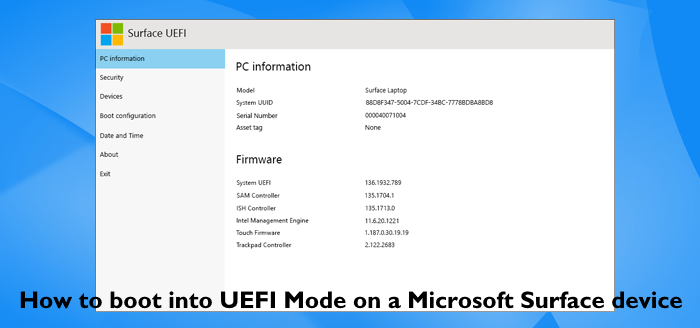The UEFI or Unified Extensible Firmware Interface on Microsoft Surface devices offers a faster startup, new features, and better security. It is a replacement for the traditional BIOS of a computer and can be used to manage firmware settings on a Surface device. There should not be much of a need to ever change these settings under normal conditions. But if you wish, you can toggle a number of settings like Battery limiter, Boot order, Secure boot and more. In this guide, we will be checking out how to boot into UEFI Settings on any Surface device running Windows 11/10.

How to Boot into UEFI Mode on a Surface device
There are two methods to boot into UEFI Mode on a Microsoft Surface device. They are as follows:
- Using the hardware key combinations.
- Use the Windows 10 Settings app.
- Use the Windows 11 Settings app.
1] Using the hardware key combinations
Make sure that your Surface device is completely shut down.
Wait for 10 seconds or more. After that, press the Power button + Volume Up (Volume +) button together for a few seconds.
Release the Power button as soon as the boot logo shows up but keep holding the Volume Up or Volume + button.
You can now release the Volume Up or Volume + button as soon as you land on the UEFI Firmware Settings page.
2] Use the Windows 10 Settings app
Open the Windows 10 Settings App and navigate to the following path:
Update & Security > Recovery
Under the section of Advanced Options, select Restart now.

When it boots in the Advanced Options screen, select the options in the given order:
Troubleshoot > Advanced Options > UEFI Firmware Settings > Restart
The device will boot into the UEFI Firmware settings page on your Microsoft Surface device.
3] Use the Windows 11 Settings app
If you have a Surface Book 2, Surface Book 3, Surface Pro X, Surface Pro 7, Surface Pro 7+, or other supported Surface devices, then you can use the Windows 11 Settings app to boot into UEFI mode. Here are the steps:
- Press the Win+I shortcut key to open the Windows 11 Settings app
- Navigate to System > Recovery > and select Restart now button in the Advanced startup option
- When the Choose an option screen appears, navigate to Troubleshoot > Advanced options > UEFI Firmware Settings
- Select the Restart option.
That’s it!
How do I put my Surface in boot mode?
If you want to boot Surface from a USB drive at startup, first plug in a bootable USB drive. Access the Surface UEFI screen, and depending on your Surface device, access the Boot configuration or Boot order, select your USB Storage device, then Exit , and use the Restart Now option.
How do I reset my Surface Pro from UEFI?
The option to reset a Surface Pro device from UEFI is not available. But, there are other ways to reset your Surface Pro device. For example, if you are using Windows 11 system, then first open the Settings app. And, in the System category, access the Recovery page, and click on the Reset PC button. After that, you can select the Keep my files option or the Remove everything option and proceed to reset your device.
Hope it helps.